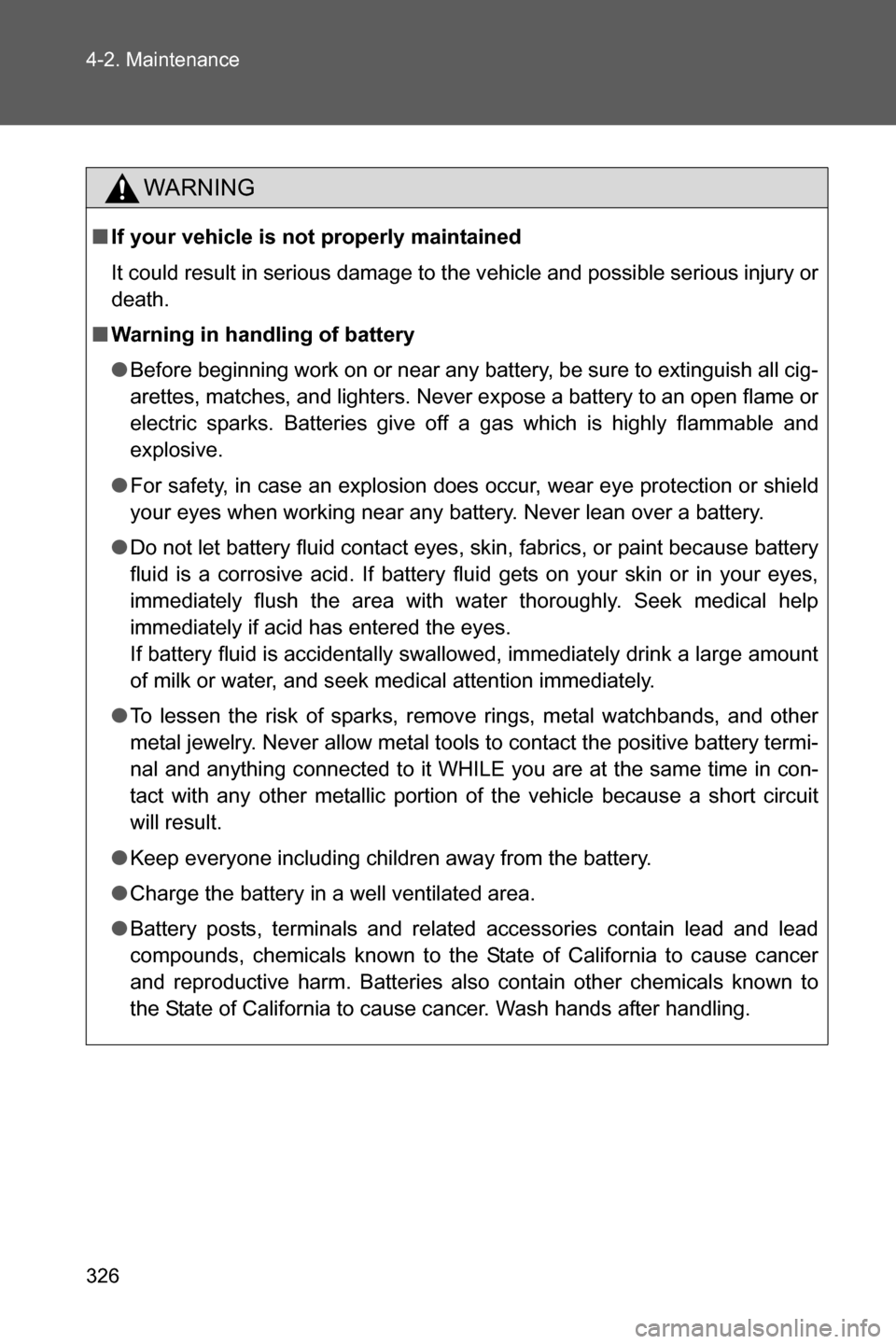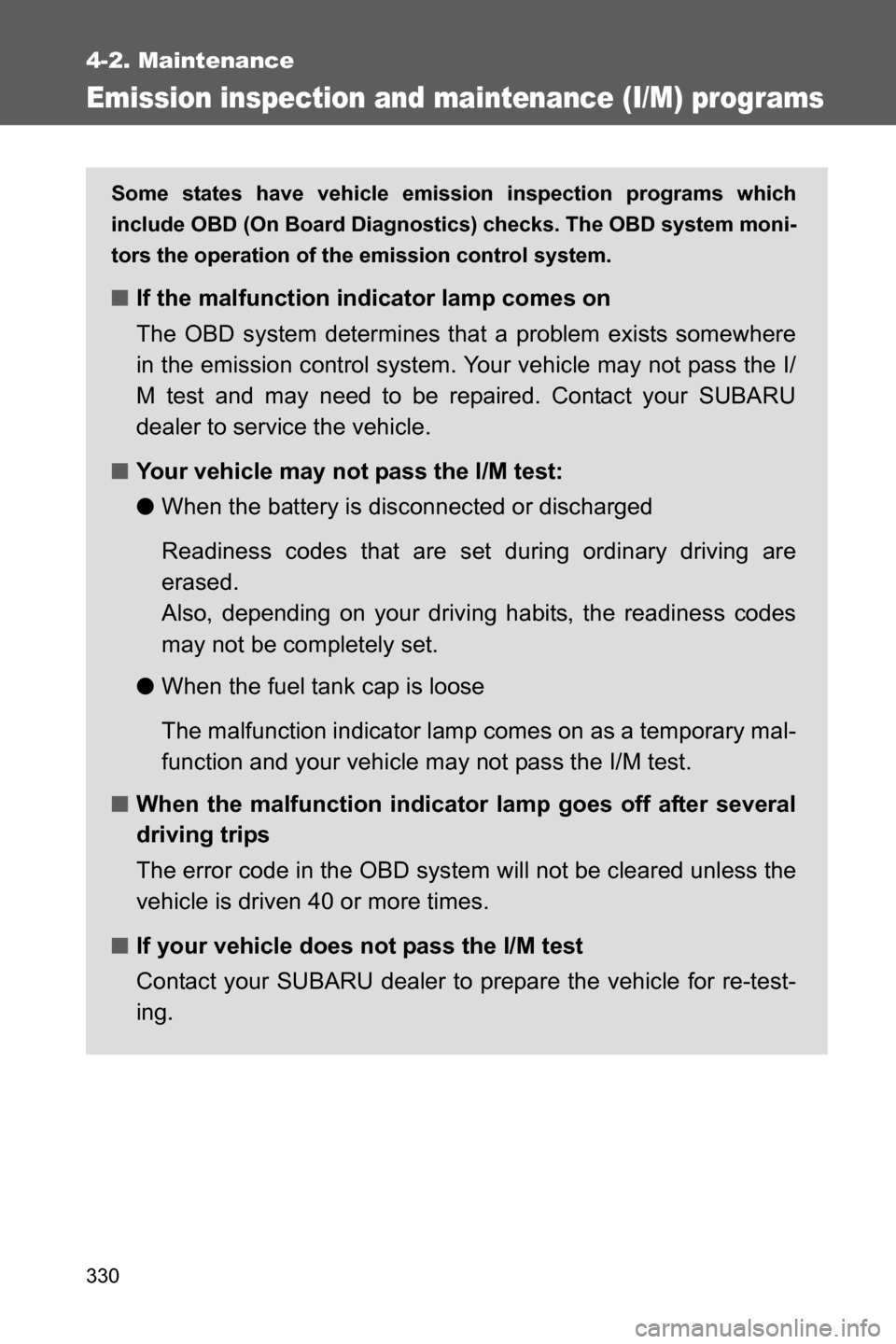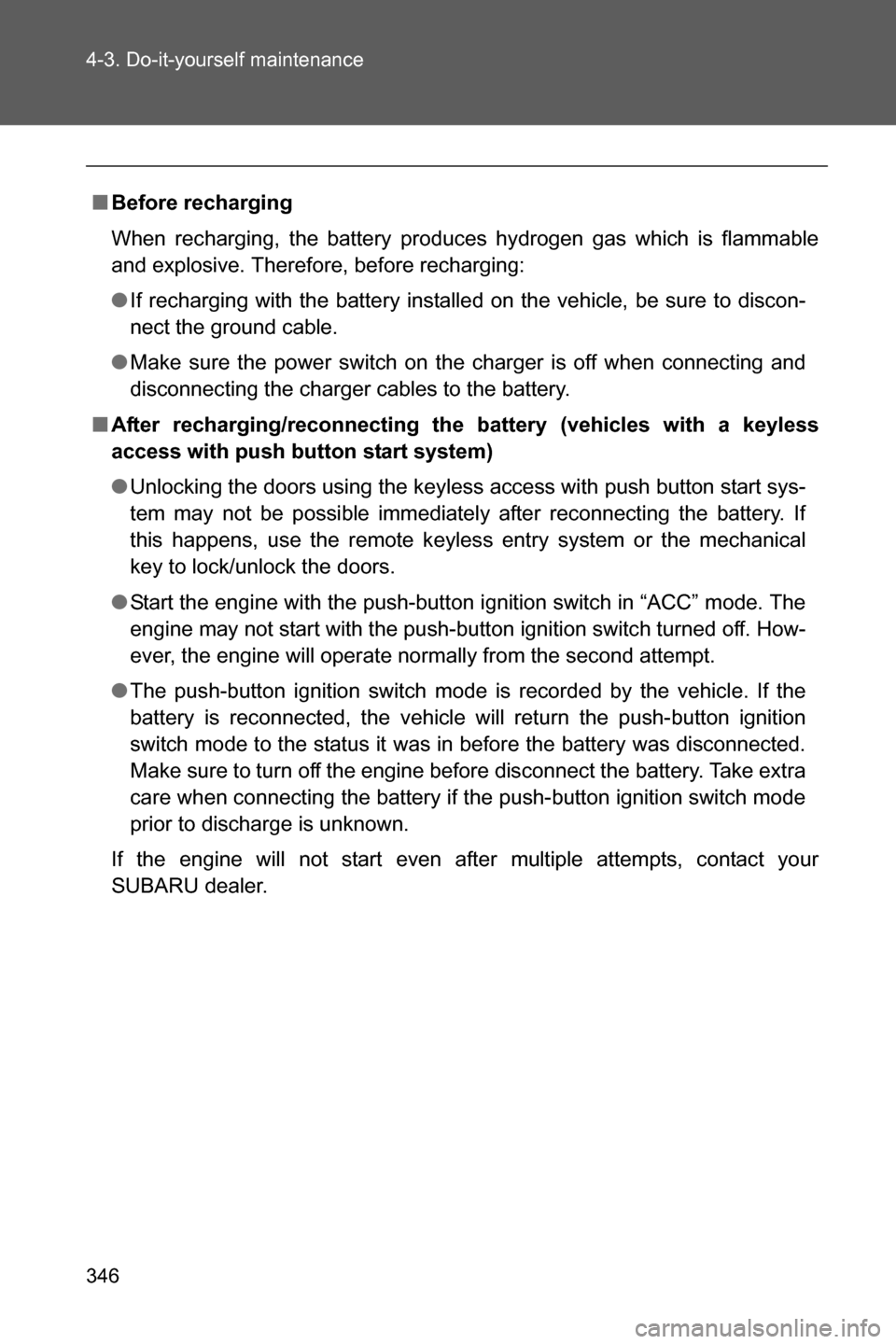Page 328 of 540

326 4-2. Maintenance
WARNING
■If your vehicle is not properly maintained
It could result in serious damage to the vehicle and possible serious injury or
death.
■Warning in handling of battery
●Before beginning work on or near any battery, be sure to extinguish all cig-
arettes, matches, and lighters. Never expose a battery to an open flame or
electric sparks. Batteries give off a gas which is highly flammable and
explosive.
●For safety, in case an explosion does occur, wear eye protection or shield
your eyes when working near any battery. Never lean over a battery.
●Do not let battery fluid contact eyes, skin, fabrics, or paint because battery
fluid is a corrosive acid. If battery fluid gets on your skin or in your eyes,
immediately flush the area with water thoroughly. Seek medical help
immediately if acid has entered the eyes.
If battery fluid is accidentally swallowed, immediately drink a large amount
of milk or water, and seek medical attention immediately.
●To lessen the risk of sparks, remove rings, metal watchbands, and other
metal jewelry. Never allow metal tools to contact the positive battery termi-
nal and anything connected to it WHILE you are at the same time in con-
tact with any other metallic portion of the vehicle because a short circuit
will result.
●Keep everyone including children away from the battery.
●Charge the battery in a well ventilated area.
●Battery posts, terminals and related accessories contain lead and lead
compounds, chemicals known to the State of California to cause cancer
and reproductive harm. Batteries also contain other chemicals known to
the State of California to cause cancer. Wash hands after handling.
Page 329 of 540

327
4-2. Maintenance
4
Maintenance and care
General maintenance
Engine compartment
NOTE
SUBARU does not endorse the use of non-SUBARU approved flushing sys-
tems and strongly advises against performing these services on a SUBARU
vehicle. Non-SUBARU approved flushing systems use chemicals and/or sol-
vents which have not been tested or approved by SUBARU.
SUBARU warranties do not cover any part of the vehicle which is damaged
by adding or applying chemicals and/or solvents other than those approved
or recommended by SUBARU.
ItemsCheck points
BatteryCheck the connections.
(�oP. 344)
Brake fluid At the correct level? (�oP. 342)
Engine coolant At the correct level? (�oP. 340)
Engine oil At the correct level? (�oP. 337)
Exhaust system No fumes or strange sounds?
Radiator/condenser/hosesNot blocked with foreign matter?
(�oP. 342)
Washer fluid At the correct level? (�oP. 348)
Listed below are the general maintenance items that should be per-
formed at the intervals specified in the “Warranty and Maintenance
Booklet” (except for Canada) or “Warranty and Service Booklet” (for
Canada). It is recommended that any problem you notice should be
brought to the attention of your SUBARU dealer or qualified service
shop for advice.
Page 332 of 540

330
4-2. Maintenance
Emission inspection and maintenance (I/M) programs
Some states have vehicle emission inspection programs which
include OBD (On Board Diagnostics) checks. The OBD system moni-
tors the operation of the emission control system.
■If the malfunction indicator lamp comes on
The OBD system determines that a problem exists somewhere
in the emission control system. Your vehicle may not pass the I/
M test and may need to be repaired. Contact your SUBARU
dealer to service the vehicle.
■Your vehicle may not pass the I/M test:
●When the battery is disconnected or discharged
Readiness codes that are set during ordinary driving are
erased.
Also, depending on your driving habits, the readiness codes
may not be completely set.
●When the fuel tank cap is loose
The malfunction indicator lamp comes on as a temporary mal-
function and your vehicle may not pass the I/M test.
■When the malfunction indicator lamp goes off after several
driving trips
The error code in the OBD system will not be cleared unless the
vehicle is driven 40 or more times.
■If your vehicle does not pass the I/M test
Contact your SUBARU dealer to prepare the vehicle for re-test-
ing.
Page 333 of 540

331
4
Maintenance and care
4-3. Do-it-yourself maintenance
Do-it-yourself ser vice precautions
If you perform maintenance yourself, be sure to follow the correct
procedure as given in these sections.
ItemsParts and tools
Battery condition (�oP. 344)•Warm water
• Baking soda
• Grease
• Conventional wrench
(for terminal clamp bolts)
• Distilled water
Brake fluid level (�oP. 342)• FMVSS No.116 fresh DOT 3 or
DOT 4 brake fluid
• Rag or paper towel
• Funnel (used only for adding
brake fluid)
Engine coolant level (�oP. 340)• SUBARU Super Coolant or simi-
lar high-quality ethylene glycol-
based non-silicate, non-amine,
non-nitrite and non-borate coolant
with long-life hybrid organic acid
technology.
SUBARU Super Coolant is pre-
mixed with 50% coolant and
50% deionized water.
• Funnel (used only for adding
engine coolant)
Engine oil level (�oP. 337)• SUBARU approved engine oil or
equivalent
• Rag or paper towel, funnel (used
only for adding engine oil)
Fuses (�oP. 372)• Fuse with same amperage rating
as original
Page 335 of 540

333 4-3. Do-it-yourself maintenance
4
Maintenance and care
WARNING
The engine compartment contains many mechanisms and fluids that may
move suddenly, become hot, or become electrically energized. To avoid death
or serious injury, observe the following precautions.
■When working in the engine compartment
●Keep hands, clothing, and tools away from the moving fan and engine
drive belt.
●Be careful not to touch the engine, radiator, exhaust manifold, etc. right
after driving as they may be hot. Oil and other fluids may also be hot.
●Do not leave anything that may burn easily, such as paper or rags, in the
engine compartment.
●Do not smoke, cause sparks or expose an open flame to fuel or the bat-
tery. Fuel and battery fumes are flammable.
●Be extremely cautious when working on the battery. It contains poisonous
and corrosive sulfuric acid.
■When working near the electric cooling fans or radiator grille
Vehicles without a keyless access with push button start system: Be sure the
engine switch is off. With the engine switch in the “ON” position, the electric
cooling fans may automatically start to run if the air conditioning is on and/or
the coolant temperature is high. (�oP. 342)
Vehicles with a keyless access with push button start system: Be sure the
push-button ignition switch is off. With the push-button ignition switch in
“ON” mode, the electric cooling fans may automatically start to run if the air
conditioning is on and/or the coolant temperature is high. (�oP. 342)
■Safety glasses
Wear safety glasses to prevent flying or falling material, fluid spray, etc. from
getting in the eyes.
CAUTION
■If you remove the air cleaner filter
Driving with the air cleaner filter removed may cause excessive engine wear
due to dirt in the air. Also a backfire could cause a fire in the engine compart-
ment.
Page 338 of 540
336
4-3. Do-it-yourself maintenance
Engine compartment
Battery (�oP. 344)
Engine oil level dipstick
(�oP. 3 3 7 )
Brake fluid reservoir
(�oP. 342)
Engine oil filler cap
(�oP. 3 3 8 )Washer fluid tank
(�oP. 3 4 8 )
Electric cooling fans
Condenser (�oP. 3 4 2 )
Radiator (�oP. 3 4 2 )
Engine coolant reservoir
(�oP. 3 4 0 )
Fuse box (�oP. 3 7 2 )
Page 346 of 540
344 4-3. Do-it-yourself maintenance
Battery
Check the battery as follows.
■Battery exterior
Make sure that the battery terminals are not corroded and that
there are no loose connections, cracks, or loose clamps.
Hold-down clamp
Te r m i n a l s
■Checking battery fluid
Check that the level is between
“UPPER LEVEL” and “LOWER
LEVEL”.
“UPPER LEVEL”
“LOWER LEVEL”
If the fluid level is at or below
“LOWER LEVEL”, add distilled
water.
Page 348 of 540

346 4-3. Do-it-yourself maintenance
■Before recharging
When recharging, the battery produces hydrogen gas which is flammable
and explosive. Therefore, before recharging:
●If recharging with the battery installed on the vehicle, be sure to discon-
nect the ground cable.
●Make sure the power switch on the charger is off when connecting and
disconnecting the charger cables to the battery.
■After recharging/reconnecting the battery (vehicles with a keyless
access with push button start system)
●Unlocking the doors using the keyless access with push button start sys-
tem may not be possible immediately after reconnecting the battery. If
this happens, use the remote keyless entry system or the mechanical
key to lock/unlock the doors.
●Start the engine with the push-button ignition switch in “ACC” mode. The
engine may not start with the push-button ignition switch turned off. How-
ever, the engine will operate normally from the second attempt.
●The push-button ignition switch mode is recorded by the vehicle. If the
battery is reconnected, the vehicle will return the push-button ignition
switch mode to the status it was in before the battery was disconnected.
Make sure to turn off the engine before disconnect the battery. Take extra
care when connecting the battery if the push-button ignition switch mode
prior to discharge is unknown.
If the engine will not start even after multiple attempts, contact your
SUBARU dealer.